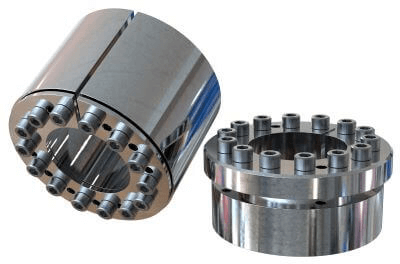What Is a Power Lock?

A Power Lock is a friction-type fastener mainly used to fasten a shaft and a boss.
Power Lock uses the wedge principle to obtain frictional force and is characterized by its ability to fasten two parts with non-backlash by simply tightening the bolt. Backlash refers to the play caused by the meshing of gears, while non-backlash refers to the absence of play in the gears.
Uses of Power Locks
Power Lock is used to fasten mechanical elements such as rotating shafts, pulleys, and gears in various industrial machines. They are also used in semiconductor manufacturing devices and food processing machines. The characteristics of wear-type fastening devices are mainly used in fields such as conveying, packaging, and printing machinery.
In these applications, the phase level can be adjusted with only one bolt, for example, for final positioning of powertrain components such as pulleys and sprockets. In addition, the design requires less space because the adjustment can be made from the side of the rotating parts. We also offer an environmentally resistant series to meet the needs of clean rooms.
Principles of Power Locks
The outer ring and inner ring, which are in contact with each other on the tapered surface, are spread over the inner and outer diameters by the fastening bolt, creating a frictional force between the shaft parts and housing parts.
Some hydro-hydraulic systems are based on Pascal’s principle. In the hydro-hydraulic system, a screw pressurizes and compresses the pressure medium sealed inside the sleeve to generate a frictional force between the shaft parts and housing parts.
Features of Power Lock
Frictional fasteners using wedges, such as Power Lock, are characterized by their low cost and versatility. On the other hand, they require time and labor for installation and dismounting.
Hydro-hydraulic systems are slightly more expensive than wedge mechanical systems, but they are very easy to maintain, and their ease of installation and removal, as well as their speed and precision, are also advantages of hydro-hydraulic systems. The wedge-mechanical system is relatively compact but can handle high torques.
However, because of the large number of screws used, removal takes a lot of time, and care must be taken not to forget to tighten the screws. In contrast, the hydro-hydraulic system is easier to install and remove, more accurate, and superior to the mechanical system if cost is not a factor.
Other Information about Power Locks
1. Tightening Torque of Power Locks
Power Lock transmits torque by friction with the shaft. To achieve the specified transmission torque, the tightening torque of the tightening bolt and the dimensional tolerance of the shaft must be controlled.
The tightening torque for bolts is listed in the manufacturer’s technical data and ranges from 11.1 to 18.4 Nm for a shaft diameter of 20 mm, which varies from model to model. The transmission torque at this time is 61.7 to 62.7 Nm. The recommended tolerance of the shaft dimensions is h6 for φ38 or smaller and h8 for φ40 or larger, and if the dimensions are too small, the transmission torque will be reduced. Conversely, if the dimension is too large, mounting will not be possible.
Tighten the bolts diagonally and gradually to ensure uniform tightening. Finally, set the torque wrench to the specified torque and tighten all bolts. This prevents over-tightening.
Although multiple Power Locks can be installed on a single shaft, it should be noted that the transmitted torque is not simply proportional to the quantity. According to the manufacturer’s data, the torque is 1.55 times higher with two locks and 1.85 times higher with three locks.
2. How to Remove the Power Lock
When removing Power Lock, loosen the pressurizing bolt to release the tightening by the wedge. However, some power locks that have been tightened for a long period of time may be stuck and cannot be simply removed by loosening the bolts. In this case, screw the bolt into the extraction tap next to the pressurized bolt hole and forcibly pull off the fastener.
It must also be ensured that no load or torque is applied to the Power Lock during removal. If the Power Lock pops out or rotates during removal, it may cause a serious accident.